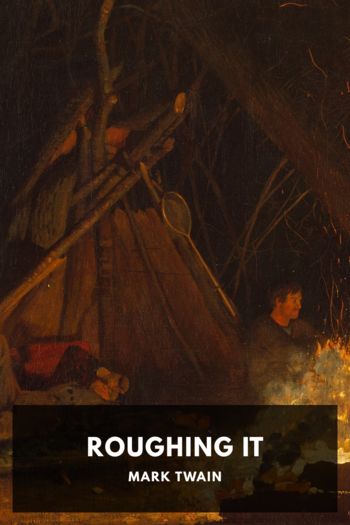Roughing It, Mark Twain [dark books to read .TXT] 📗

- Author: Mark Twain
Book online «Roughing It, Mark Twain [dark books to read .TXT] 📗». Author Mark Twain
For a brief sketch of Mormon history, and the noted Mountain Meadow massacre, see Appendices A and B. ↩
Milton ↩
And what makes that worn anecdote the more aggravating, is, that the adventure it celebrates never occurred. If it were a good anecdote, that seeming demerit would be its chiefest virtue, for creative power belongs to greatness; but what ought to be done to a man who would wantonly contrive so flat a one as this? If I were to suggest what ought to be done to him, I should be called extravagant—but what does the sixteenth chapter of Daniel say? Aha! ↩
Washoe people take a joke so hard that I must explain that the above description was only the rule; there were many honorable exceptions in Carson—plastered ceilings and houses that had considerable furniture in them. —M. T. ↩
However, one prophecy was verified, at any rate. It was asserted by the desperadoes that one of their brethren (Joe McGee, a special policeman) was known to be the conspirator chosen by lot to assassinate Williams; and they also asserted that doom had been pronounced against McGee, and that he would be assassinated in exactly the same manner that had been adopted for the destruction of Williams—a prophecy which came true a year later. After twelve months of distress (for McGee saw a fancied assassin in every man that approached him), he made the last of many efforts to get out of the country unwatched. He went to Carson and sat down in a saloon to wait for the stage—it would leave at four in the morning. But as the night waned and the crowd thinned, he grew uneasy, and told the barkeeper that assassins were on his track. The barkeeper told him to stay in the middle of the room, then, and not go near the door, or the window by the stove. But a fatal fascination seduced him to the neighborhood of the stove every now and then, and repeatedly the barkeeper brought him back to the middle of the room and warned him to remain there. But he could not. At three in the morning he again returned to the stove and sat down by a stranger. Before the barkeeper could get to him with another warning whisper, someone outside fired through the window and riddled McGee’s breast with slugs, killing him almost instantly. By the same discharge the stranger at McGee’s side also received attentions which proved fatal in the course of two or three days. ↩
The customary canal technicality for “tie up.” ↩
Mr. Valentine, Wells Fargo’s agent, has handled all the bullion shipped through the Virginia office for many a month. To his memory—which is excellent—we are indebted for the following exhibit of the company’s business in the Virginia office since the first of January, 1862: From January 1st to April 1st, about $270,000 worth of bullion passed through that office, during the next quarter, $570,000; next quarter, $800,000; next quarter, $956,000; next quarter, $1,275,000; and for the quarter ending on the 30th of last June, about $1,600,000. Thus in a year and a half, the Virginia office only shipped $5,330,000 in bullion. During the year 1862 they shipped $2,615,000, so we perceive the average shipments have more than doubled in the last six months. This gives us room to promise for the Virginia office $500,000 a month for the year 1863 (though perhaps, judging by the steady increase in the business, we are under estimating, somewhat). This gives us $6,000,000 for the year. Gold Hill and Silver City together can beat us—we will give them $10,000,000. To Dayton, Empire City, Ophir and Carson City, we will allow an aggregate of $8,000,000, which is not over the mark, perhaps, and may possibly be a little under it. To Esmeralda we give $4,000,000. To Reese River and Humboldt $2,000,000, which is liberal now, but may not be before the year is out. So we prognosticate that the yield of bullion this year will be about $30,000,000. Placing the number of mills in the Territory at one hundred, this gives to each the labor of producing $300,000 in bullion during the twelve months. Allowing them to run three hundred days in the year (which none of them more than do), this makes their work average $1,000 a day. Say the mills average twenty tons of rock a day and this rock worth $50 as a general thing, and you have the actual work of our one hundred mills figured down “to a spot”—$1,000 a day each, and $30,000,000 a year in the aggregate.—Enterprise. [A considerable over estimate —M. T.] ↩
Since the above was in type, I learn from an official source that the above figure is too high, and that the yield for 1863 did not exceed $20,000,000. However, the day for large figures is approaching; the Sutro Tunnel is to plow through the Comstock lode from end to end, at a depth of two thousand feet, and then mining will be easy and comparatively inexpensive; and the momentous matters of drainage, and hoisting and hauling of ore will cease to be burdensome. This vast work will absorb many years, and millions of dollars, in its completion; but it will early yield money, for that desirable epoch will begin as soon as it strikes the first end of the vein. The tunnel will be some eight miles long, and will develop astonishing riches. Cars will carry the ore through the tunnel and dump it in the mills and thus do away with the present costly system of double handling and transportation by mule teams. The water from the tunnel will furnish the motive power for the mills. Mr. Sutro, the originator of this prodigious enterprise, is one of the few men in the





Comments (0)